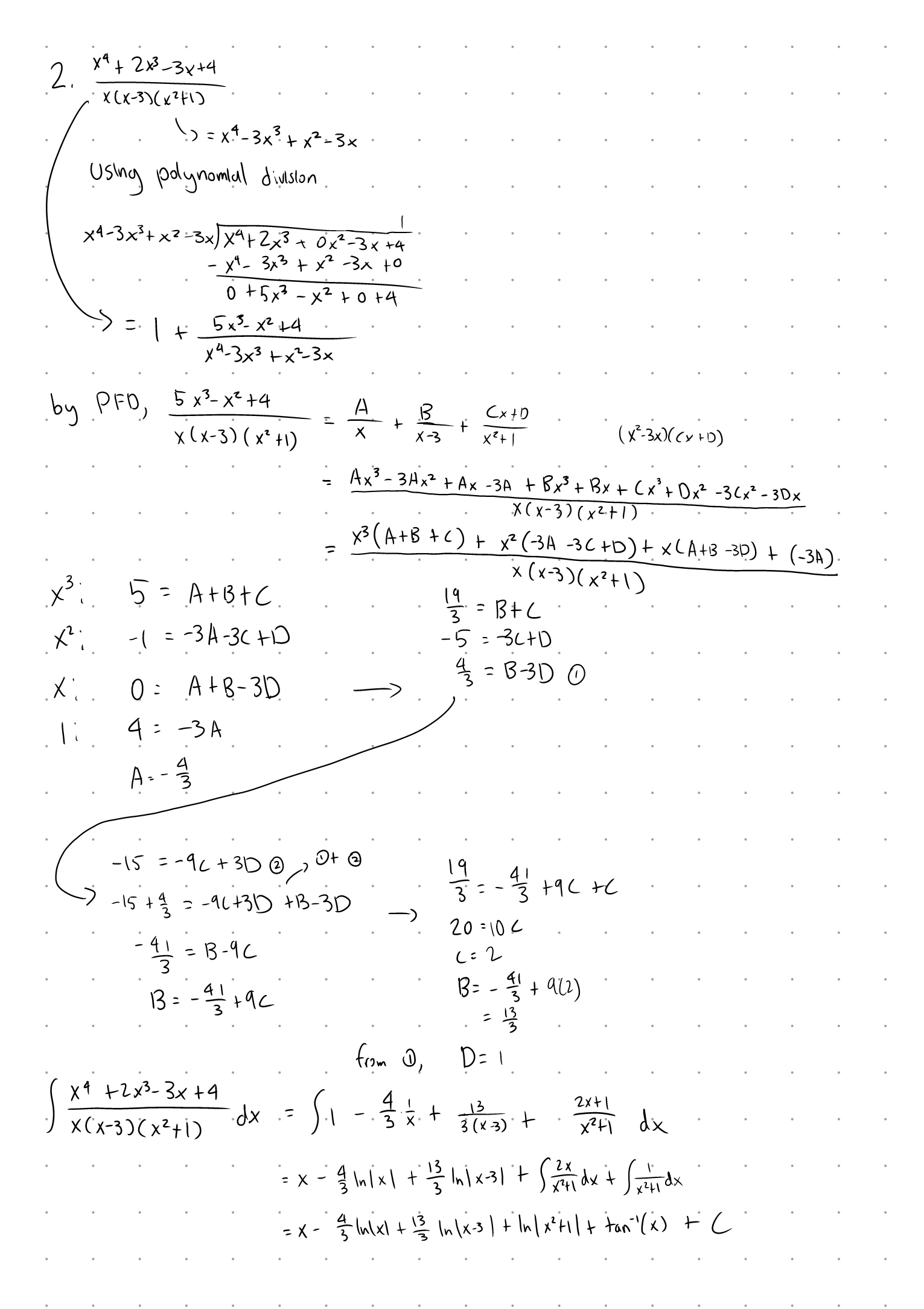Tutorial Week 4
Partial Fraction Decomposition (PFD)
Partial fraction decomposition is a way to simplify rational integrals into a way that is easier to work with by seperating the rational expression into its partial fractions.
Q1: Integrate \(\int \frac{x^4+2x^3-3x+4}{x(x-3)(x^2+1)} \; dx\).
Riemann Sums and Sigma Notation
Sigma Notation
We use sigma (\(\Sigma\)) notation as a way to express sums of numbers.
With \(\Sigma_{n=3}^5n^2\), we sum from \(n = 3\) to \(n = 5\) inclusive, giving \(\Sigma_{n=3}^5n^2 = 3^2 + 4^2 + 5^2\).
With sums, we also have a few useful formulas, those being:
\(\Sigma_{k = m}^n ca_k = c\Sigma_{k = m}^n a_k\)
\(\Sigma_{k = m}^n a_k + b_k = \Sigma_{k = m}^n a_k + \Sigma_{k = m}^n b_k\)
\(\Sigma_{k = 1}^n 1 = n\)
\(\Sigma_{k = 1}^n n = \frac{n(n+1)}{2}\)
\(\Sigma_{k = 1}^n n^2 = \frac{n(n+1)(2n+1)}{6}\)
\(\Sigma_{k = 1}^n n^3 = \frac{n^2(n + 1)^2}{4}\)
Riemann Sums
Riemann sums are used to approximate the area under a function by using rectangles.
To define a riemann sum from on the interval [a, b] for f(x), we need:
\(\Delta x = \frac{b - a}{n}\)
\(x_k = a + k\Delta x\) for \(k = 0, 1, 2, ... , n\)
\(x^\ast_k\) is a point in \([x_{k-1}, x_k]\)
The riemann sum is \(\Sigma_{k=1}^n f(x_n^\ast)\Delta x\).
We have two common types of riemann sums, those being the left riemann sum and the right riemann sum.
The left riemann sum is defined with \(x^\ast_k = x_{k-1}\) so that \(L_n = \Sigma_{k=1}^n f(x_{k-1})\Delta x = \Sigma_{k=1}^n f(a + (k-1)\Delta x)\Delta x\).
The right riemann sum is defined with \(x^\ast_k = x_{k}\) so that \(R_n = \Sigma_{k=1}^n f(x_{k})\Delta x = \Sigma_{k=1}^n f(a + k\Delta x)\Delta x\).
The midpoint sum is defined with \(x^\ast_k = x_{k} = \frac{x_{k-1} + x_k}{2}\) so that \(M_n = \Sigma_{k=1}^n f(\frac{x_{k-1} + x_k}{2}) \Delta x\).
Q2: Approximate the area under \(10 - x^2\) for \(x \in [0, 1]\) using the midpoint sum over four intervals.
Directing plugging this into the riemann sum formula gives us
\(\sum_{k=1}^4 f(x_k^\ast)\Delta x = \Delta x \sum_{k=1}^4 f(x_k^\ast)\)
\(= \Delta x (f(x_1^\ast) + f(x_2^\ast) + f(x_3^\ast) + f(x_4^\ast))\)
Remember that \(x_k = a + k\Delta x\) for \(k = 0, 1, 2, ... , n\)
so using \(a = 0\) and \(\Delta x = \frac{1}{4}\) from the interval of \(x\) we want to approximate the area for, we have
\(x_0 = 0, x_1 = \frac{1}{4}, x_2 = \frac{1}{2}, x_3 = \frac{3}{4}, x_4 = 1\).
Since \(x^\ast_k = x_{k} = \frac{x_{k-1} + x_k}{2}\),
\(x^\ast_1 = \frac{0 + \frac{1}{4}}{2}, x^\ast_2 = \frac{\frac{1}{4} + \frac{1}{2}}{2}, \dots\) and so on.
We end up with
\(x^\ast_1 = \frac{1}{8}, x^\ast_2 = \frac{3}{8}, x^\ast_3 = \frac{5}{8}, x^\ast_4 = \frac{7}{8}\).
Using these points, the midpoint sum is
Q3: Evaluate \(\int_0^4 2x^2 + x \,dx\) using Riemann sums.
For simplicity, let’s use the right riemann sum.
We have:
\(\Delta x = \frac{b - a}{n} = \frac{4 - 0}{n} = \frac{4}{n}\)
\(x_k = a + k\Delta x = 0 + \frac{4k}{n}\) for \(k = 0, 1, 2, ... , n\)
\(x^\ast_k = x_{k} = \frac{4k}{n}\) since we’re using the right Riemann sum.
So then
Solving for this gives us
